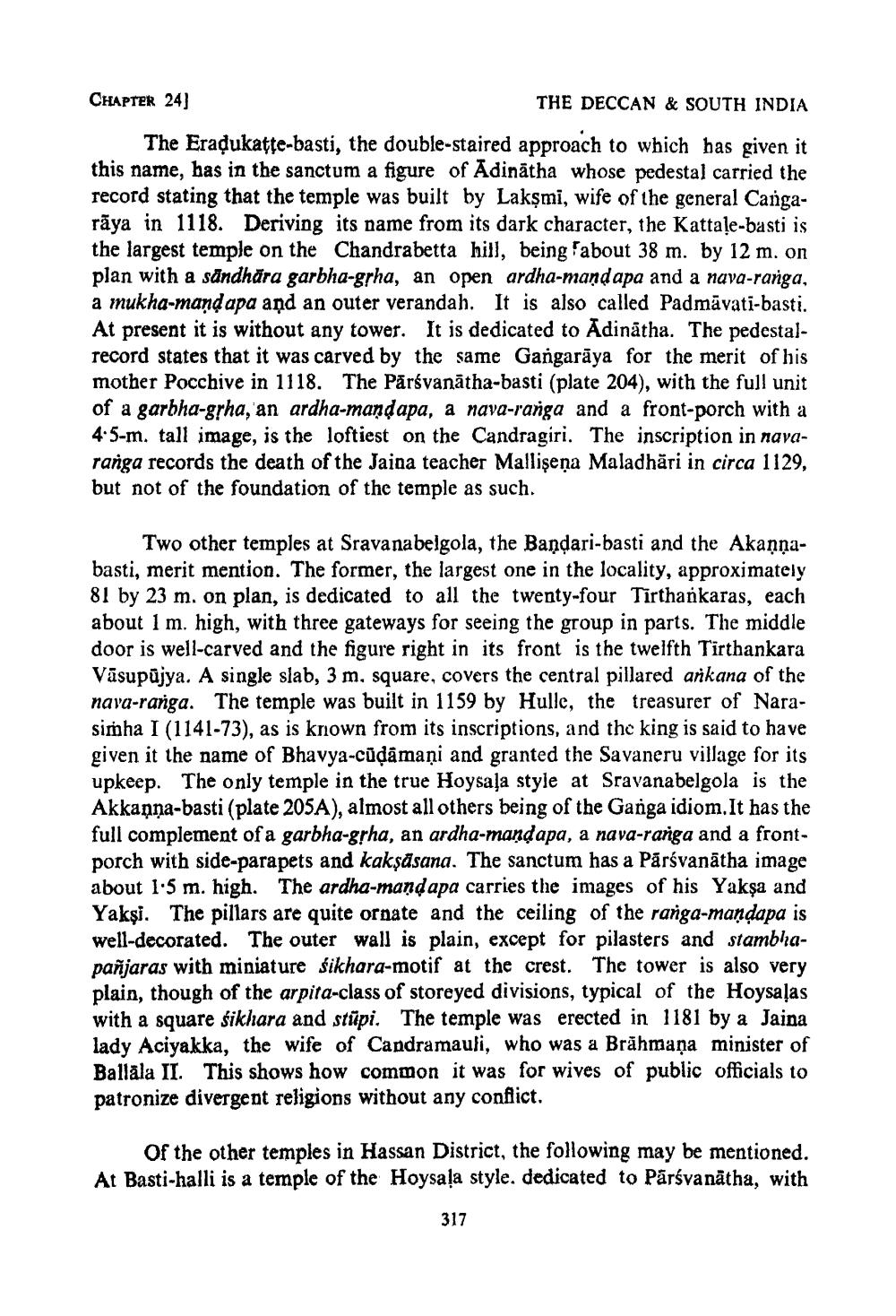________________
CHAPTER 24
THE DECCAN & SOUTH INDIA The Eradukatte-basti, the double-staired approach to which has given it this name, has in the sanctum a figure of Adinātha whose pedestal carried the record stating that the temple was built by Lakşmi, wife of the general Cangarāya in 1118. Deriving its name from its dark character, the Kattale-basti is the largest temple on the Chandrabetta hill, being about 38 m. by 12 m. on plan with a sandhāra garbha-gsha, an open ardha-mand apa and a nava-ranga, a mukha-mand apa and an outer verandah. It is also called Padmāvati-basti. At present it is without any tower. It is dedicated to Adinātha. The pedestalrecord states that it was carved by the same Gangarāya for the merit of his mother Pocchive in 1118. The Pārsvanātha-basti (plate 204), with the full unit of a garbha-grha, an ardha-mand apa, a nava-ranga and a front-porch with a 4:5-m. tall image, is the loftiest on the Candragiri. The inscription in navaranga records the death of the Jaina teacher Mallişeņa Maladhări in circa 1129, but not of the foundation of the temple as such.
Two other temples at Sravanabelgola, the Bandari-basti and the Akannabasti, merit mention. The former, the largest one in the locality, approximately 81 by 23 m. on plan, is dedicated to all the twenty-four Tirthankaras, each about 1 m. high, with three gateways for seeing the group in parts. The middle door is well-carved and the figure right in its front is the twelfth Tirthankara Väsupujya. A single slab, 3 m, square, covers the central pillared arkana of the nava-ranga. The temple was built in 1159 by Hulle, the treasurer of Narasimha I (1141-73), as is known from its inscriptions, and the king is said to have given it the name of Bhavya-cūdamaņi and granted the Savaneru village for its upkeep. The only temple in the true Hoysala style at Sravanabelgola is the Akkaņņa-basti (plate 205A), almost all others being of the Ganga idiom. It has the full complement of a garbha-grha, an ardha-mandapa, a nava-ranga and a frontporch with side-parapets and kakşasana. The sanctum has a Pārsvanātha image about 1.5 m. high. The ardha-mandapa carries the images of his Yakşa and Yaksi. The pillars are quite ornate and the ceiling of the ranga-mandapa is well-decorated. The outer wall is plain, except for pilasters and stambhapanjaras with miniature sikhara-motif at the crest. The tower is also very plain, though of the arpita-class of storeyed divisions, typical of the Hoysaļas with a square sikhara and stūpi. The temple was erected in 1181 by a Jaina lady Aciyakka, the wife of Candramauli, who was a Brāhmaṇa minister of Ballala II. This shows how common it was for wives of public officials to patronize divergent religions without any conflict.
Of the other temples in Hassan District, the following may be mentioned. At Basti-halli is a temple of the Hoysala style, dedicated to Pārsvanātha, with
317




